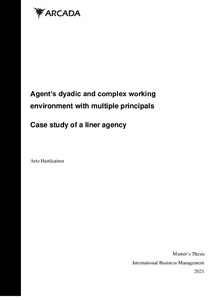Agent's dyadic and complex working environment with multiple principals - Case study of a liner agency
Hartikainen, Arto (2021)
Hartikainen, Arto
2021
All rights reserved. This publication is copyrighted. You may download, display and print it for Your own personal use. Commercial use is prohibited.
Julkaisun pysyvä osoite on
https://urn.fi/URN:NBN:fi:amk-2021052812198
https://urn.fi/URN:NBN:fi:amk-2021052812198
Tiivistelmä
This study is qualitative research that aims to illuminate on how agents, who are involved in multiple principal-agent relationships, perceive their working environment and which control mechanisms are used to control their actions. It explicitly searches to answer the following research questions: 1. How do the interviewees perceive their working environment? 2. How do the interviewees identify towards the organization? 3. What kind of agency problems can be recognized from the interviews? In communicating the aim of this study, it draws on literature of agency theory and stewardship theory. The study is conducted as theme-centered interviews among five industry professionals, who are ranked as top management in their countries. All the interviewees in the study work for the same group, which means that this is a case study, investigating phenomena in a specific environment. The results indicate that the interviewees perceive their working environment as dyadic and complex because different principals have different needs and all of them are running their own agenda. The interviewees’ role is trying to satisfy all the needs of their principals, which is impossible. Also, the contracts between the principals make the interviewees working environment even more complex as they do not support success for both parties. The interviewees identify themselves more towards their own companies, rather than towards any principal. The clearest result in identification is that when the interviewees must choose to whom they are loyal to, the principal who pays their salaries or the principals whose business they run, the interviewees tend to choose the one that pays their salaries. Three different agency problems are recognized from the data and they are in line with agency theory’s assumption about the most common problems present in principal-agent relationships. As a conclusion, all parties within the study act according to agency theory’s description rather than stewardship theory.
